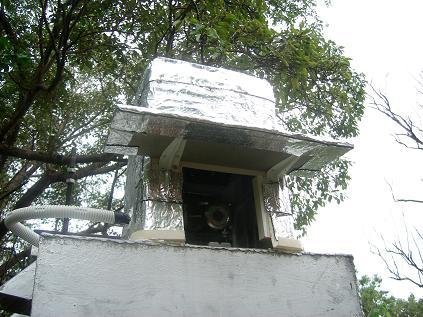
When the Department of Natural Resources of Australia decided that they needed to capture data about the natural flooding of a cave, they turned to a hacker to get results. The goal was to photograph the area during these floods with an automated system. In the end, they used a gutted Lumix digital camera mounted in a trash can, covered in aluminium foil. Though it sounds a bit silly, the final product turned out quite nice. You can see the build log, schematics, and results on the project page.
[via hackedgadgets]















Free lumix camera for anyone who can get there first!
And you get an alien proof psychic helmet!
His capacitor is drawn upside-down.
Indeed, the rounded part is the minus and the straight line the plus.
Mind you since in normal diagrams the ground is represented by a short straight line you can see how he got confused.
Handy link: http://en.wikipedia.org/wiki/Electronic_symbol
I also don’t see a need to first open the camera and then solder wires but still using relays, why not a FET or optocoupler to switch if you got wires on it?
YOU COULD DIE!
“His capacitor is drawn upside-down.”
The capacitor only looks upside-down to you, because he is in Australia.
I’m skeptical about this design. To me, it looks as if it were easy for insects to get into the case and mess up both the circuitry and the camera. Why not put the camera into a sealed box?
@Dan
Apparently, the heat. 35 C is pretty hot, and while the camera would produce negligible heat on its own, you might want it a bit cooler than that.
I agree though, maybe put a screen over any air intakes to keep out insects.
@PocketBrain, others FYI – the capacitor polarity debate is a bit old. Both are deemed acceptable, although currently the straight bar as positive is more popular.
Look in some of the older versions of OrCad, they put a plus mark on the curved end.
@jwt. Agree, it also needs MOAR ARDUINO
Oldest representation of a polarized capacitor I have is 1983, and it’s with the arc being minus.
That some software had an error(?) doesn’t make it become a standard.
Plus there are international standardization bodies who decide the symbols, and national bodies like Institute of Electrical and Electronics Engineers (IEEE)in the US, that then agree to adopt those standards.
So there is no need for discussions and disagreements really, unless the national body in australia decided to do things reversed and this schematic uses the local standard, but I think it’s probably a simple error that explains it.
And a search on google I did failed in finding any place where they draw the symbol reversed.
Wow! I need a new ant farm. that things going to be so crawling with bugs in the next wet season they won’t have a hope in hell to actually get a photo of the flooding itself.